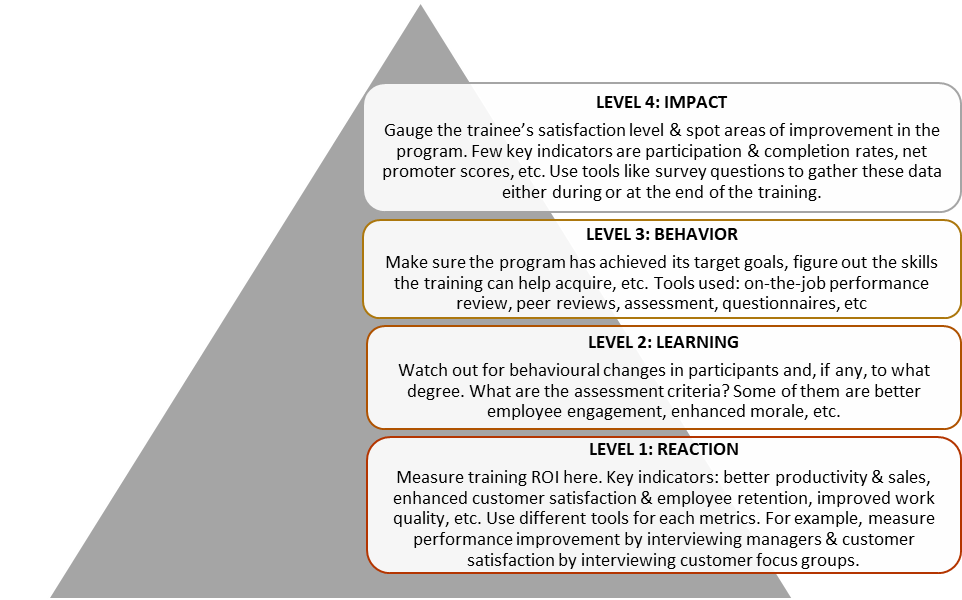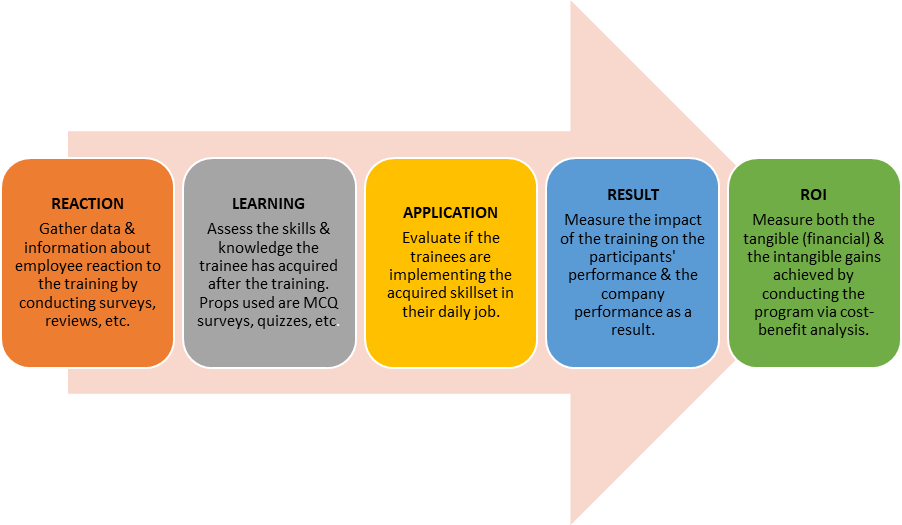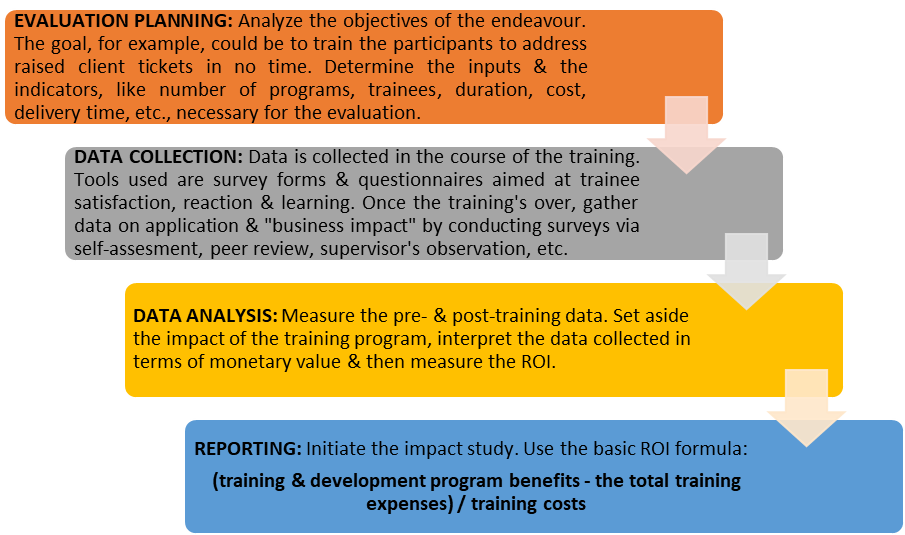It’s been a year you had been saving up for a holiday to the Fiji Islands. You made sure to book the best resort there, had the most carefully thought-out itinerary—you have spent extravagantly while planning a perfect holiday. Wouldn’t you expect a bang for your buck?
Imagine spending a fortune buying your dream car. Wouldn’t you expect top class mileage, powerful engine, world class safety features and much more? There again you seek value for your hard-earned money.
The same is true for the companies that spend a huge amount of funds on learning and development programs. The organizations too expect their investments to yield positive results. And how would they know if a particular initiative has added to their growth and if the program is worth the investment? It’s through development & training ROI calculator.
Training and development ROI is a way to calculate the financial benefits a company reaps by investing in a training program. It measures the impact—in terms of monetary profit—of a particular training endeavor on the company’s performance and business results.
There are multiple ways by which you can conclusively measure training and development ROI. Here in this blog, we give a detailed analysis of 6 mechanisms for ROI calculation for training and development. But before we dive into these functional methods, let’s see why we need to calculate ROI of training and development in the first place.
Need to calculate ROI of training and development
1. Defend the spend
Conducting a training and development program requires approval from the company’s head honchos. Use the ROI data to showcase the success of past endeavors. This will help convince the leadership to continue to invest in more such programs.
2. Helps set your priorities straight
Compare ROI of different learning and development programs. This helps identify and focus more on the ones that have the biggest impact on the company’s performance improvement.
3. Helps quantify the value
To pitch for future program to the management and the stakeholders, you need to highlight the value that such programs have added to the organizational performance in the past. Mere words will not be enough unless you corroborate it with key metrics like ROI.
5 ways to calculate the training and development ROI
Conducting a training and development program is integral to any organizational growth. But choosing the right program or defending the spend and convincing the decision-makers for investing in a training program is very challenging. It’s the development and training ROI calculator that makes it easier for you. Here’re some of the methods you can use to measure it:
1. The Kirkpatrick Model
Built and designed by Donald Kirkpatrick, this is a frequently used model for measuring training and development ROI. It comprises of four stages—Reaction, Learning, Behavior, and Results. Each of these four stages fulfils target evaluation. Here’s a detailed overview of the model:

2. The Phillips ROI Model
It’s an improvisation of Kirkpatrick’s model. Philip’s model measures ROI here by simply measuring the difference between the training results and the costs involved in conducting the program. Here’s a lowdown on Phillip’s ROI model:

Here’s how you may calculate ROI of training and development using Phillips ROI Model:
Step 1: Collect pre-training data relevant to the program
Step 2: Collect post-training data relevant to the program from proper sources like participants, supervisors, etc.
Step 3: Pick out those aspects of the program that were instrumental in improving the performances of the participants.
Step 4: gather relevant data and turn it into monitory profit. Compare that with the overall cost of the program.
Step 5: Calculate the ROI using the formula below:
ROI% = (Net Program Benefits/ Program Costs) * 100
Step 6: Interpret the ROI based on the result. The higher the net program benefit value is, the better the ROI is. If the program cost is more than the value of the program benefit, the training strategy needs a re-evaluation.
P.S: To evaluate if the participants can successfully implement the skillset they have acquired from the training, participants can conduct self-assessment using tools like 360-degree feedback. Training management software like Simply.Coach are a repository of such useful digital tools.
3. Impact Study
The third method to calculate L & D ROI is by conducting a business impact study. “Business impact” indicates changes achieved through the training. Changes could be in the shape of sales, marketing, customer satisfaction, staff retention, etc. Here’s a comprehensive representation of the 4 steps involved in the method:

4. Training ROI Calculator
A very popular method of calculating training and development ROI is by using the training ROI calculator—commonly used in jobs where financial gains can be easily isolated. It’s the ratio of the overall program cost to the organizational profit earned due to the training.
For instance, you conduct a training program for retail sales staff to improve their selling skills. You’ve incurred an overall cost of $1,00,000 on conducting the training program consisting of 20 participants. Now, let’s say that your pre-training data shows that each of your sales staff could sell 10 garments worth $50 each in a single day, which rises to 15 garments per day after the completion of the training. Hence there’s a rise in productivity worth $250 ($50*5) for one employee. Hence, the total net benefit for 20 sales staff would be $5,000 ($250*20) in a day and $5,00,000 in 100 days.
Now, with the help of the following formula, calculate the L & D ROI for the above example:
ROI = [($5,00,000 – $1,00, 000)/ 1,00,000] × 100 = 400%
5. Supervisor Assessment
Training ROI calculators are suited for more defined jobs where you can easily fetch the metrics for the net benefits. But for jobs where it’s difficult to isolate the impact of training, you can rely upon supervisor assessment when it comes to calculating training ROI.
For instance, 5 mid-level managers underwent a training program to improve their team-management skills. Let’s say that the training incurred an overall cost of $12,000. Here, the senior manager will evaluate their on-the-job performance, both before and after the training, based on certain qualities like customer service, team management, and task completion.
Now, take the evaluation results against each of the 3 qualities and convert them into tangible values needed for measuring ROI. Consider the following representative values:
Customer service: an increase by 6%
Team management: an increase by 10%
Task completion: an increase by 5%
An overall performance improvement will be: (6 + 10 + 5)/ 3 = 7%
If the average remuneration of these participants is $63,000, their average performance improvement per year in terms of finances will be 7% of $63,000 = $4,410 for one participant, and ($4,410 × 5) $22,050 for 5 trainees.
Calculate the ROI using the standard formula:
ROI% = [(22,050 – 12000)/ 12000] × 100 = 83.75%
A meticulously strategized training and development program would surely yield positive results.
To know how to design an effective leadership development program framework, read our blog here!
Additional tips and tricks
- Start collecting necessary data right from the beginning of the program. This helps avoid last-minute hassles.
- Make sure you measure the pre-training performance to use it as a yardstick for comparing it with post-training productivity. This helps you showcase improvement backed by data.
- Find means to highlight the impact of training. It can be achieved through multiple ways like comparing a team that has not undergone the program with the one that has received the training, highlight the differences between the pre- and post-training sales numbers, etc.
- “Rome wasn’t built in a day”. Similarly, it takes time before you get any visibility on the actual result of the training. Estimate and set a time frame as to when you expect to see results for a more relevant ROI measurement.
Which one to choose?
That’s the million-dollar question! And that’s what its answer depends on too: how much dollars/INR/Euros – in short, budget – would you want to allocate for the training. Apart from budget, your deciding factors include timelines and the value of the course. Using a digital tool like a training and development ROI calculator works best when the work in hand can be quantified easily and benefits are tangible in nature. Similarly, if your goals and activities are hard to quantify, you have other tools that you can leverage to gain a qualitative idea.
Sources: Kodosurvey, AIHR
FAQs
1. What is the formula for ROI calculation?
The formula for calculating ROI is:
ROI = (Net Income / Total Cost of Investment) × 100
2. What does NPS stand for in training?
NPS in training stands for Net Promoter Score. Introduced by Fred Reichheld, it refers to a “loyalty metrics” that’s related to whether a customer is satisfied or not with a particular product or service. It is an important metric that helps analyze the performance of training, e-learnings, and other related activities.
About Simply.Coach
Simply.Coach is an enterprise-grade coaching software designed to be used by individual coaches and coaching businesses. Trusted by ICF-accredited and EMCC-credentialed coaches worldwide, Simply.Coach is on a mission to elevate the experience and process of coaching with technology-led tools and solutions.
Read More:
4 Steps to Digitizating Your Corporate Training Programs
How to Design a Leadership Development Program Framework That Yields the Best Results
How to Start a Robust Mentoring Program
Coaching & Mentoring: Similarities & Differences
Investing Early: The Urgent Need to Coach Young Professionals, With Pradeep Sarin

Content Specialist @Simply.Coach
Jayashree Mukherjee is a content specialist by day and a content junkie (on OTT) by night. Passionate about traveling, street food and overturning the underuse of em dashes — she would have been a globe-trotter if she hadn’t been so lazy.









